
Anglia Railways was a train operating company in England, owned by GB Railways and later FirstGroup, that operated the Anglia franchise from January 1997 until March 2004.

National Express East Anglia (NXEA) was a train operating company in England owned by National Express that operated the Greater Anglia franchise from April 2004 until February 2012. Originally trading as One, it was rebranded National Express East Anglia in February 2008. It provided local, suburban and express services from London Liverpool Street to destinations in Essex, Hertfordshire, Cambridgeshire, Suffolk and Norfolk in the East of England.

The Great Eastern Main Line is a 114.5-mile (184.3 km) major railway line on the British railway system which connects Liverpool Street station in central London with destinations in east London and the East of England, including Shenfield, Chelmsford, Colchester, Ipswich and Norwich. Its numerous branches also connect the main line to Southminster, Braintree, Sudbury, Harwich and a number of coastal towns including Southend-on-Sea, Clacton-on-Sea, Walton-on-the-Naze and Lowestoft.
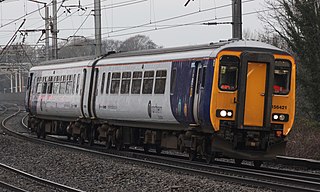
The British Rail Class 156 Super Sprinter is a diesel multiple-unit passenger train. A total of 114 sets were built between 1987 and 1989 for British Rail by Metro-Cammell's Washwood Heath works. They were built to replace elderly first-generation DMUs and locomotive-hauled passenger trains.
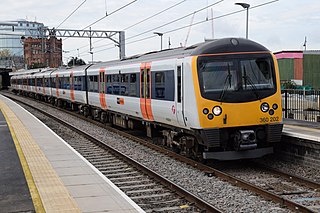
The British Rail Class 360 Desiro is an electric multiple-unit class that was built by Siemens Transportation Systems between 2002 and 2005. The Class 360 is currently operated by East Midlands Railway and Rail Operations Group.

The British Rail Class 153Super Sprinters are single-coach railcars converted from two-coach Class 155 diesel multiple units in the early 1990s. The class was intended for service on rural branch lines where passenger numbers do not justify longer trains, or to boost the capacity on trains with high passenger volume.
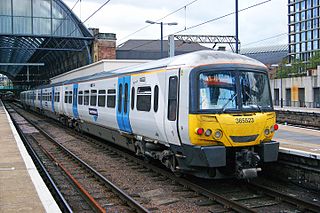
The British Rail Class 365 Networker Express are dual-voltage electric multiple-unit passenger trains built by ABB at Holgate Road Carriage Works in 1994 and 1995 to operate services in South East England and on the Great Northern Route. These were the last trains to be built at the Holgate Road works before its closure. Due to the refurbished front end resembling a smiling face, the trains have been nicknamed "Happy Trains" by enthusiasts.

The British Rail Mark 3 is a type of passenger carriage developed in response to growing competition from airlines and the car in the 1970s. A variant of the Mark 3 became the rolling stock for the High Speed Train (HST).
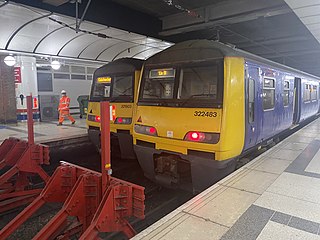
The British Rail Class 322 electric multiple units were built by British Rail Engineering Limited in 1990 for the Stansted Express service from London Liverpool Street to Stansted Airport. After becoming surplus to requirements on this route, the fleet saw further use with a number of other operators.

The British Rail Class 321 alternating current (AC) electric multiple units (EMU) were built by British Rail Engineering Limited's Holgate Road carriage works in three batches between 1988 and 1991. The design was successful and led to the development of the similar Class 320 and Class 322.

Great Yarmouth railway station is one of two eastern termini of the Wherry Lines in the East of England, serving the seaside town of Great Yarmouth, Norfolk. The other terminus at the eastern end of the lines is Lowestoft, and the western terminus to which all trains run is Norwich.

Norwich railway station is the northern terminus of the Great Eastern Main Line in the East of England, serving the city of Norwich, Norfolk. It is 114 miles 77 chains (185.0 km) down the main line from London Liverpool Street, the western terminus.

Ipswich railway station is on the Great Eastern Main Line in the East of England, serving the town of Ipswich, Suffolk. It is 68 miles 59 chains (110.6 km) down the line from London Liverpool Street and, on the main line, it is situated between Manningtree to the south and Needham Market to the north.

The British Rail Class 90 electric locomotives were built for mixed-traffic duties, operating from 25 kV AC overhead lines and produce 5,000 bhp (3,700 kW). They weigh 84.5 tonnes and can typically achieve a top speed of 110 mph (177 km/h).
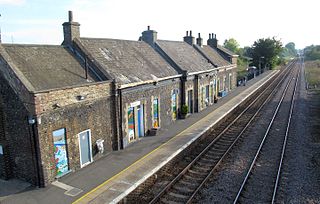
Brandon railway station is on the Breckland Line in the East of England, serving the town of Brandon, Suffolk, although the station is actually situated across the county boundary in Norfolk. The line runs between Cambridge in the west and Norwich in the east.

Greater Anglia is a train operating company in Great Britain owned as a joint venture by Abellio, the international arm of the state-owned Dutch national rail operator Nederlandse Spoorwegen, and the Japanese trading company Mitsui & Co. It operates the East Anglia franchise, providing the commuter and intercity services from its Central London terminus at London Liverpool Street to Essex, Suffolk, Norfolk and parts of Hertfordshire and Cambridgeshire as well as many regional services throughout the East of England.

The East Anglia franchise is a railway franchise for passenger trains on the Great Eastern Main Line and West Anglia Main Lines in England. It commenced operating in April 2004 when the Anglia and Great Eastern franchises, together with the West Anglia part of the West Anglia Great Northern franchise, were combined to form the Greater Anglia franchise.

The British Rail Class 755 is a class of bi-mode multiple unit train built by Stadler Rail for Greater Anglia. Part of the FLIRT modular train family, the trains first entered service on 29 July 2019 and are used on regional and local services throughout East Anglia.

The British Rail Class 745 FLIRT is a class of electric multiple unit train, built by Stadler as part of the FLIRT family. The class is built for Greater Anglia for use on their inter-city services and the Stansted Express services. They first entered service on 8 January 2020, after being constructed between 2018 and 2020 in Switzerland.
Brantham TMD was to be a depot that was planned for Greater Anglia off the Great Eastern Main Line in Brantham. Construction was halted in April 2018 due to council concerns and in July 2019 planning permission was obtained for an alternative location between Dovercourt and Harwich International.


















